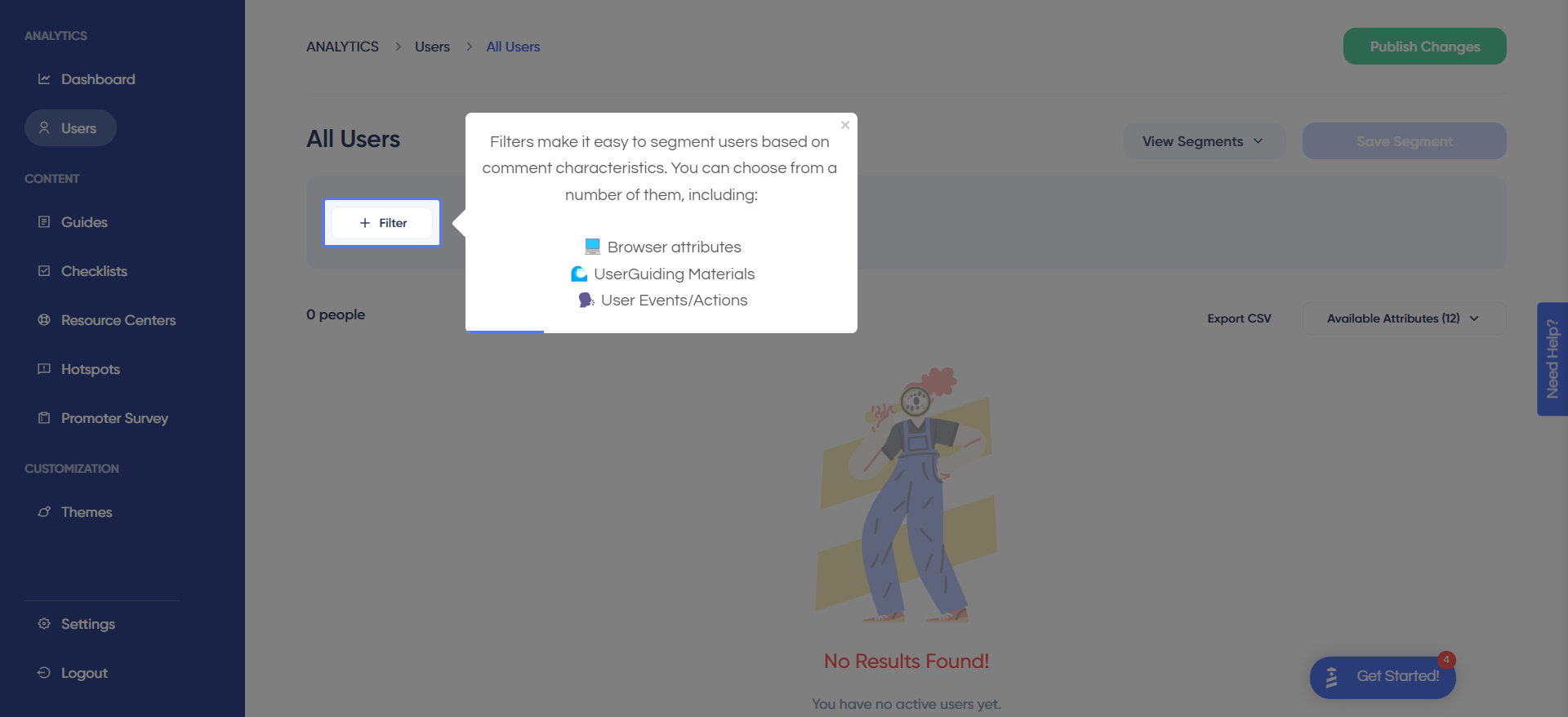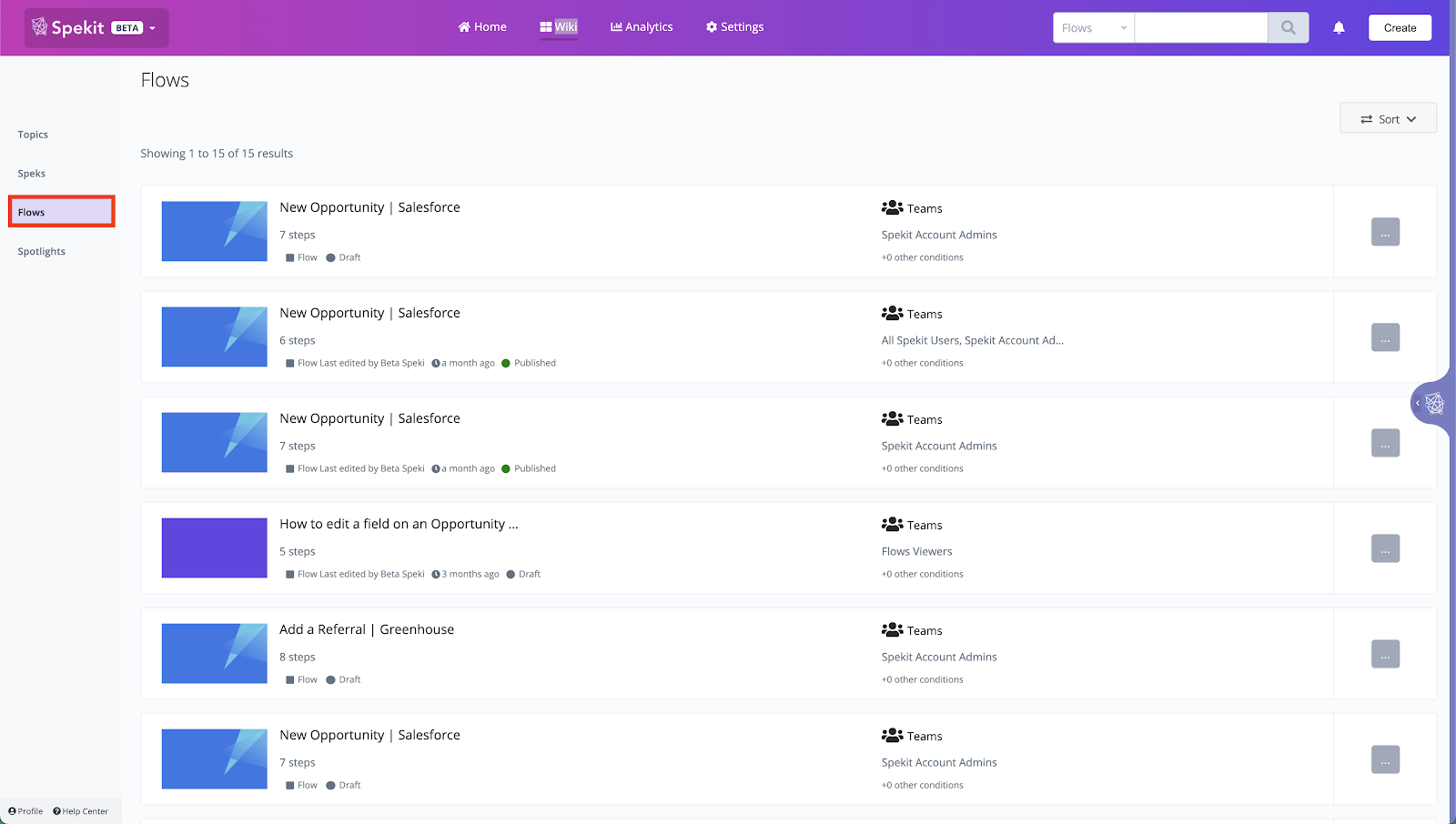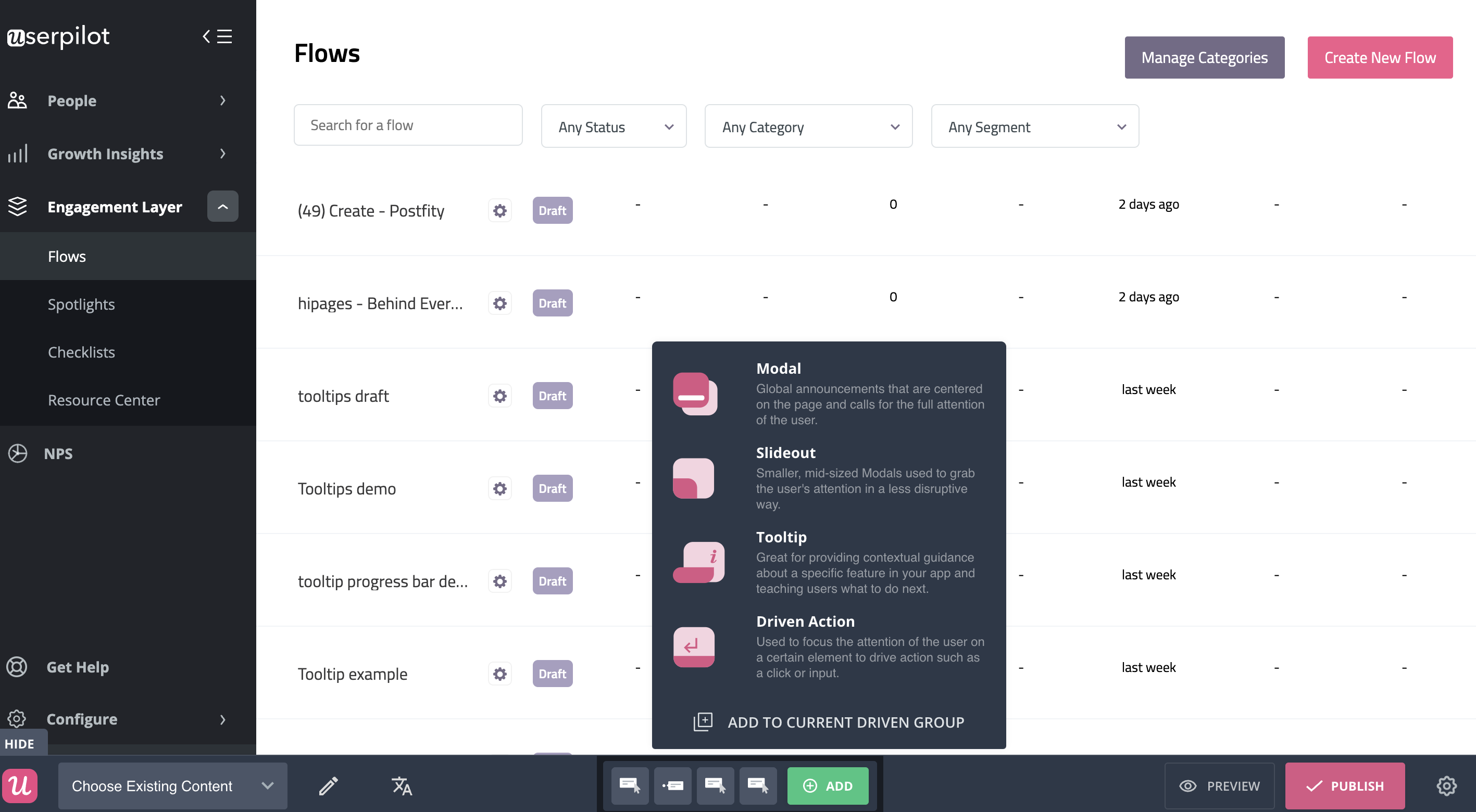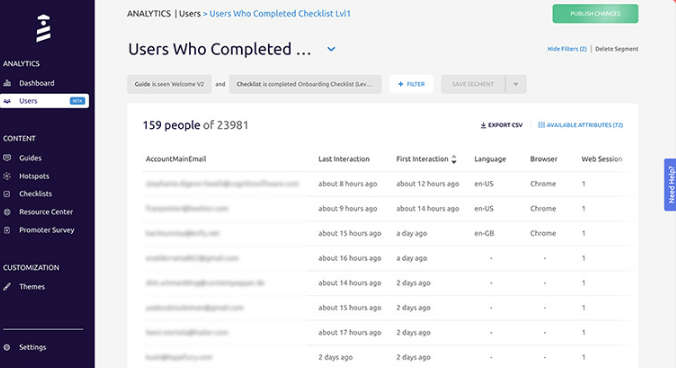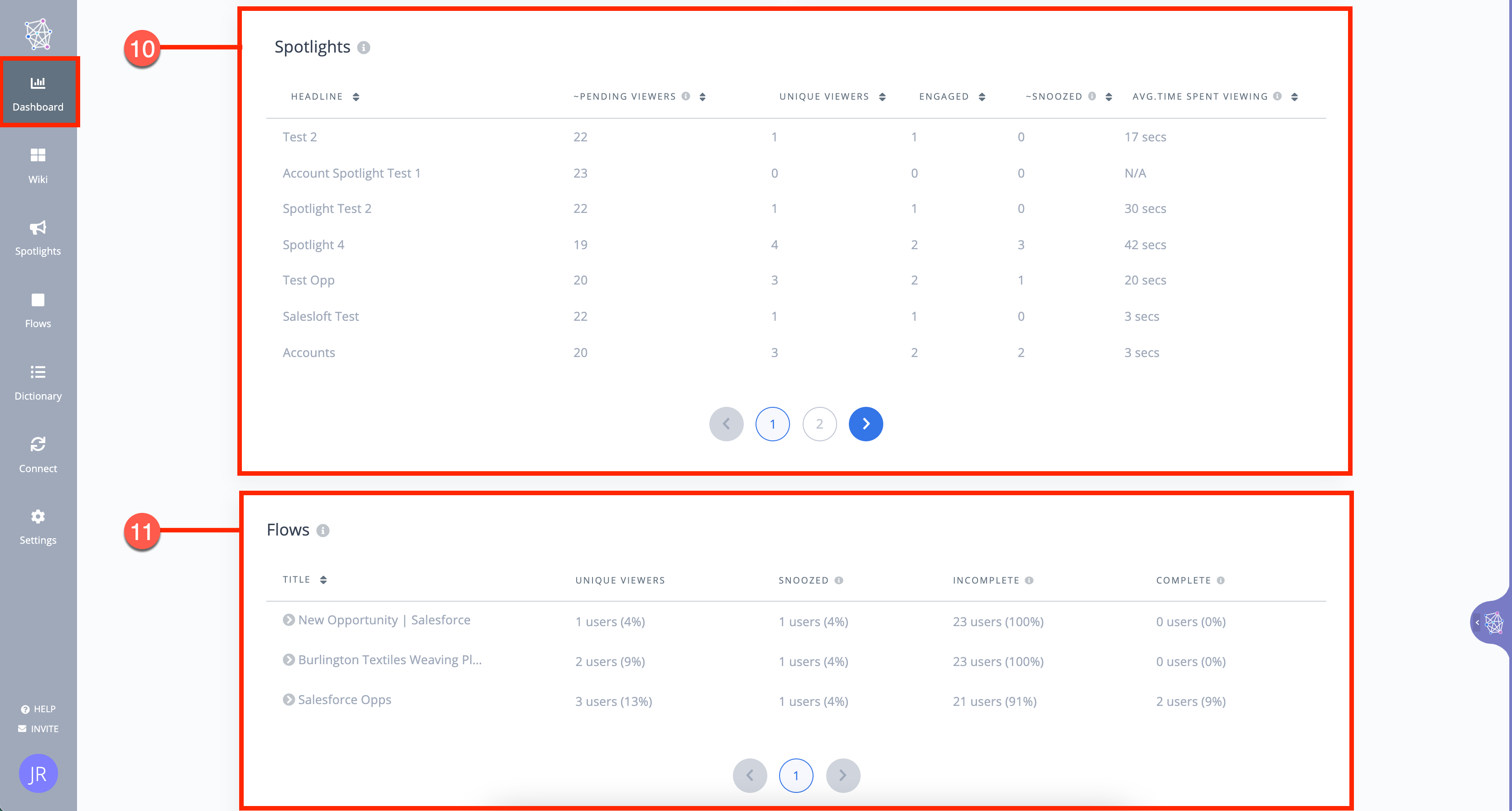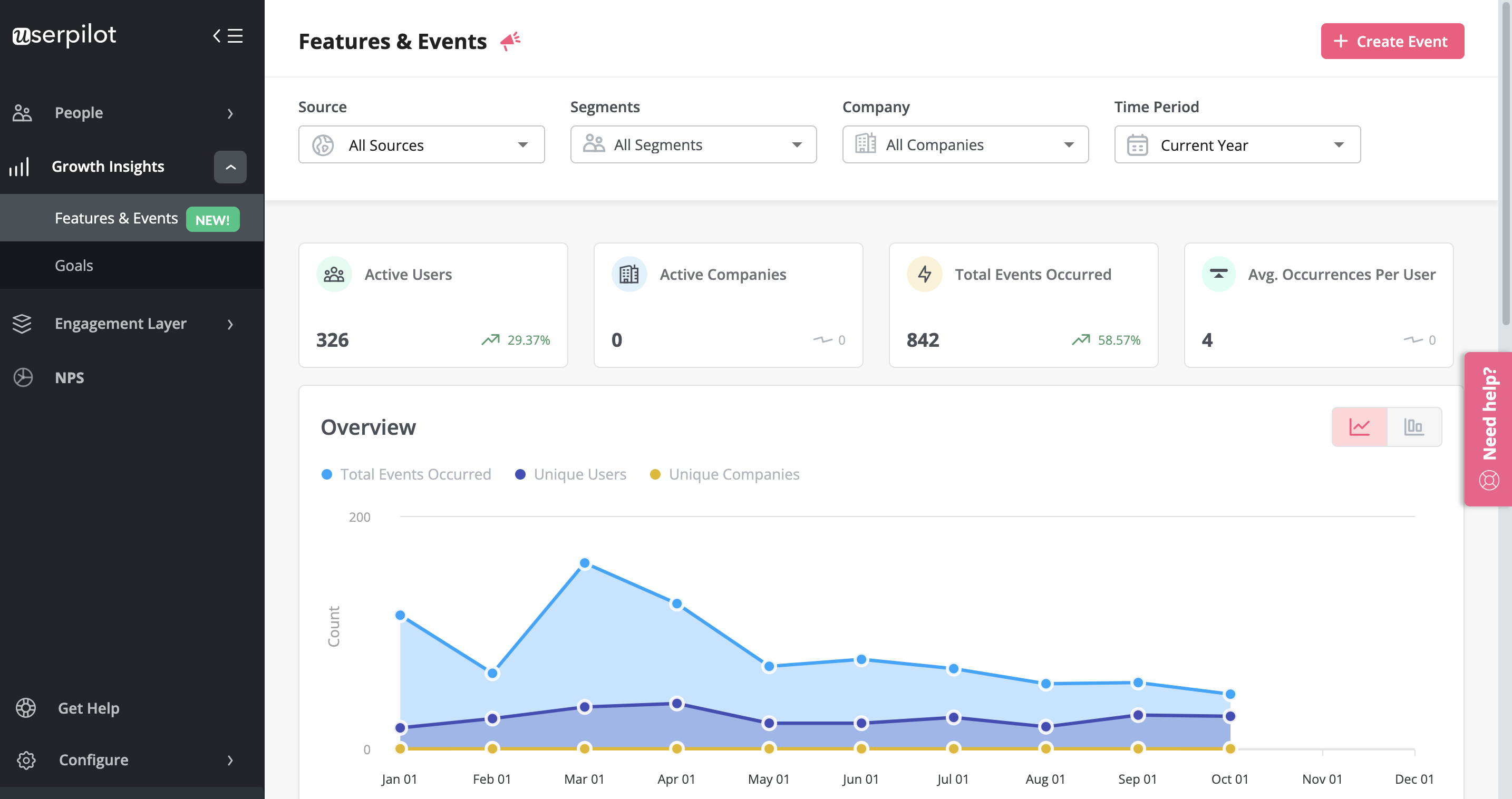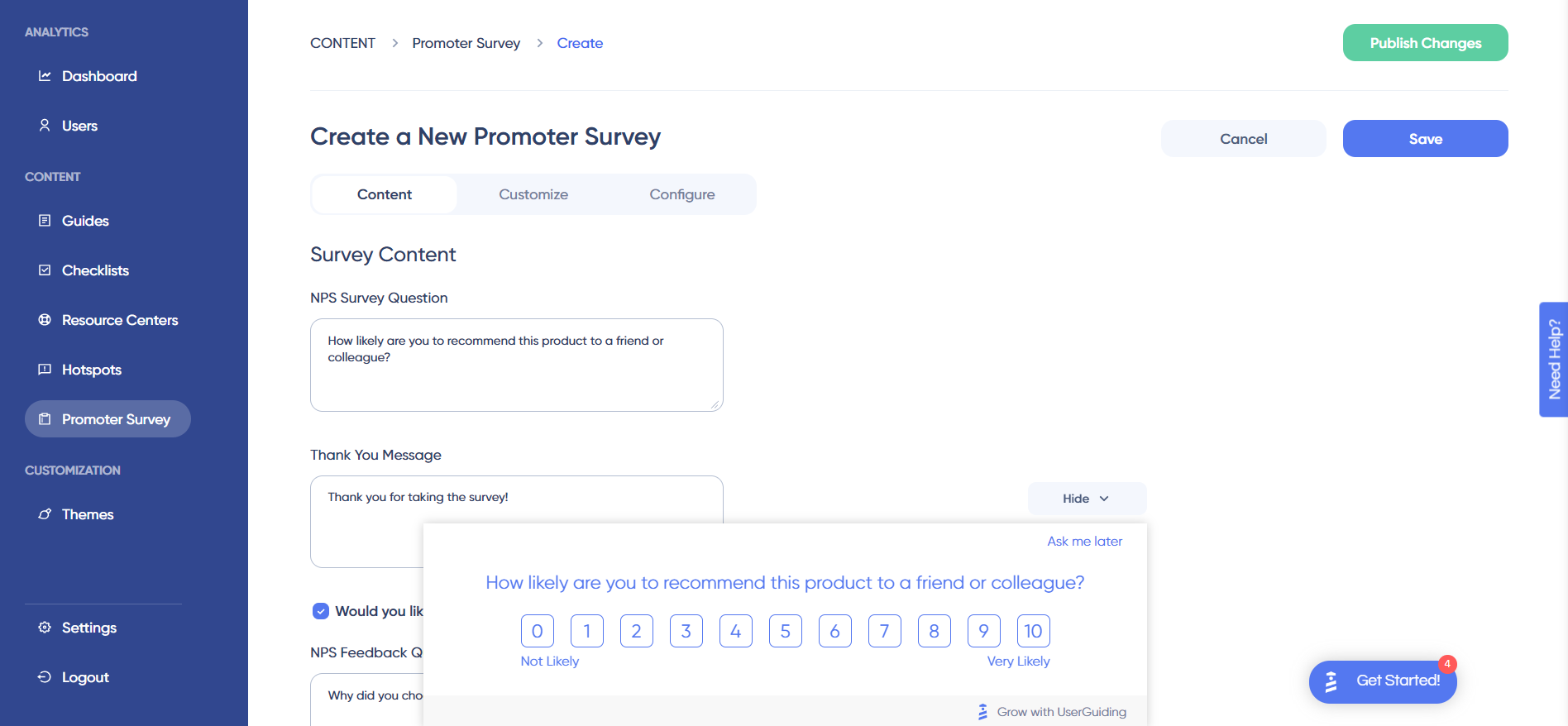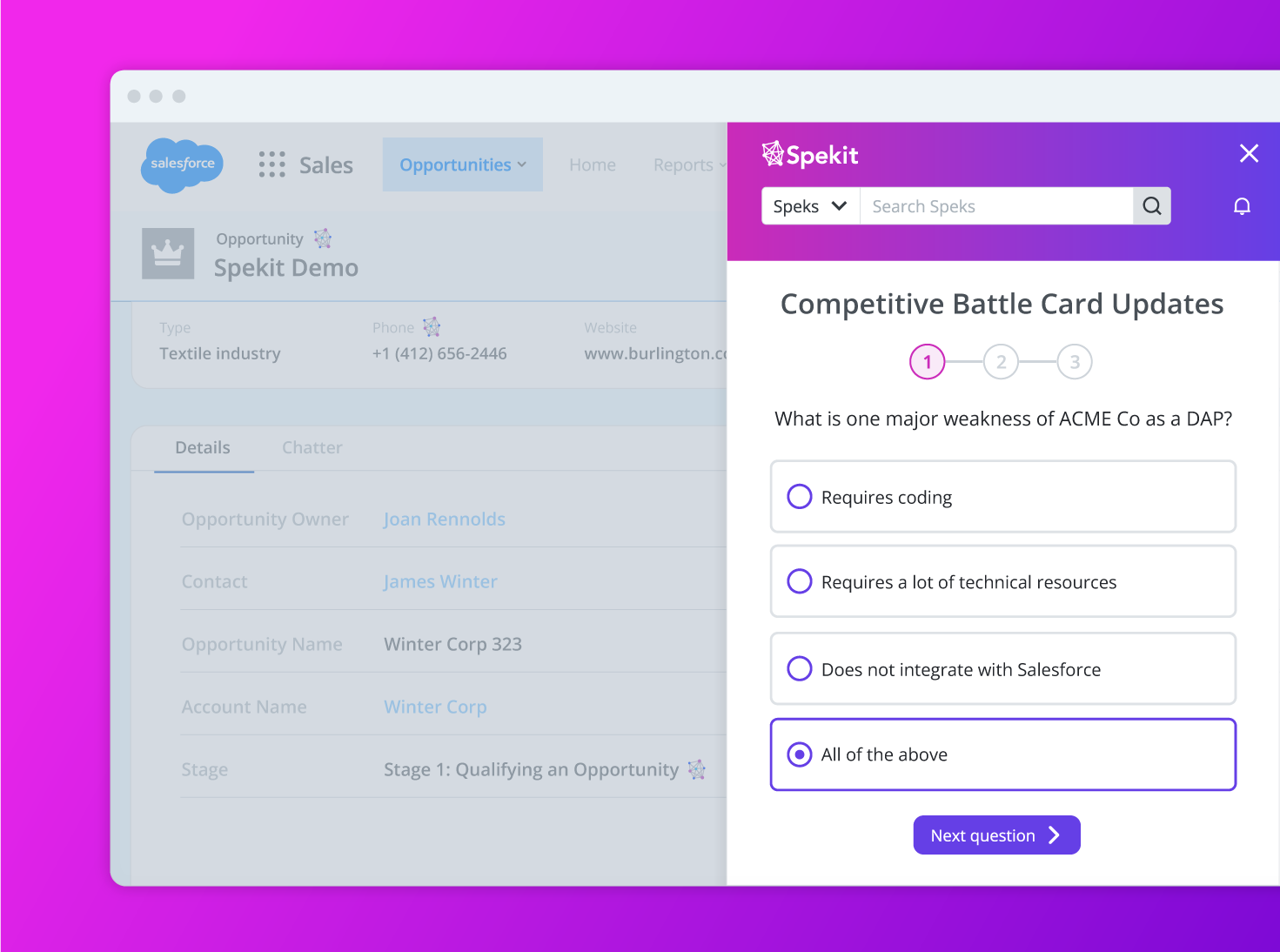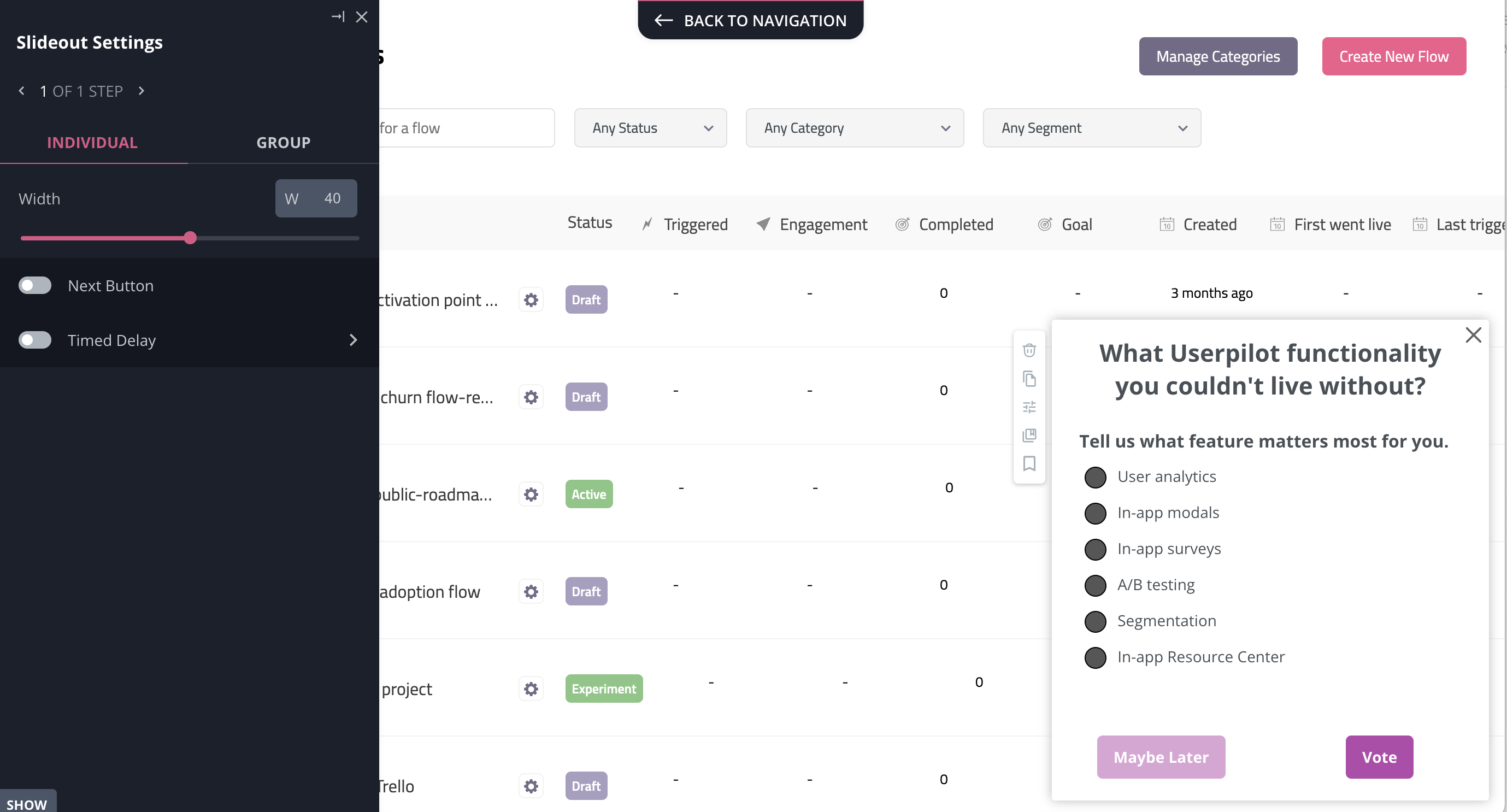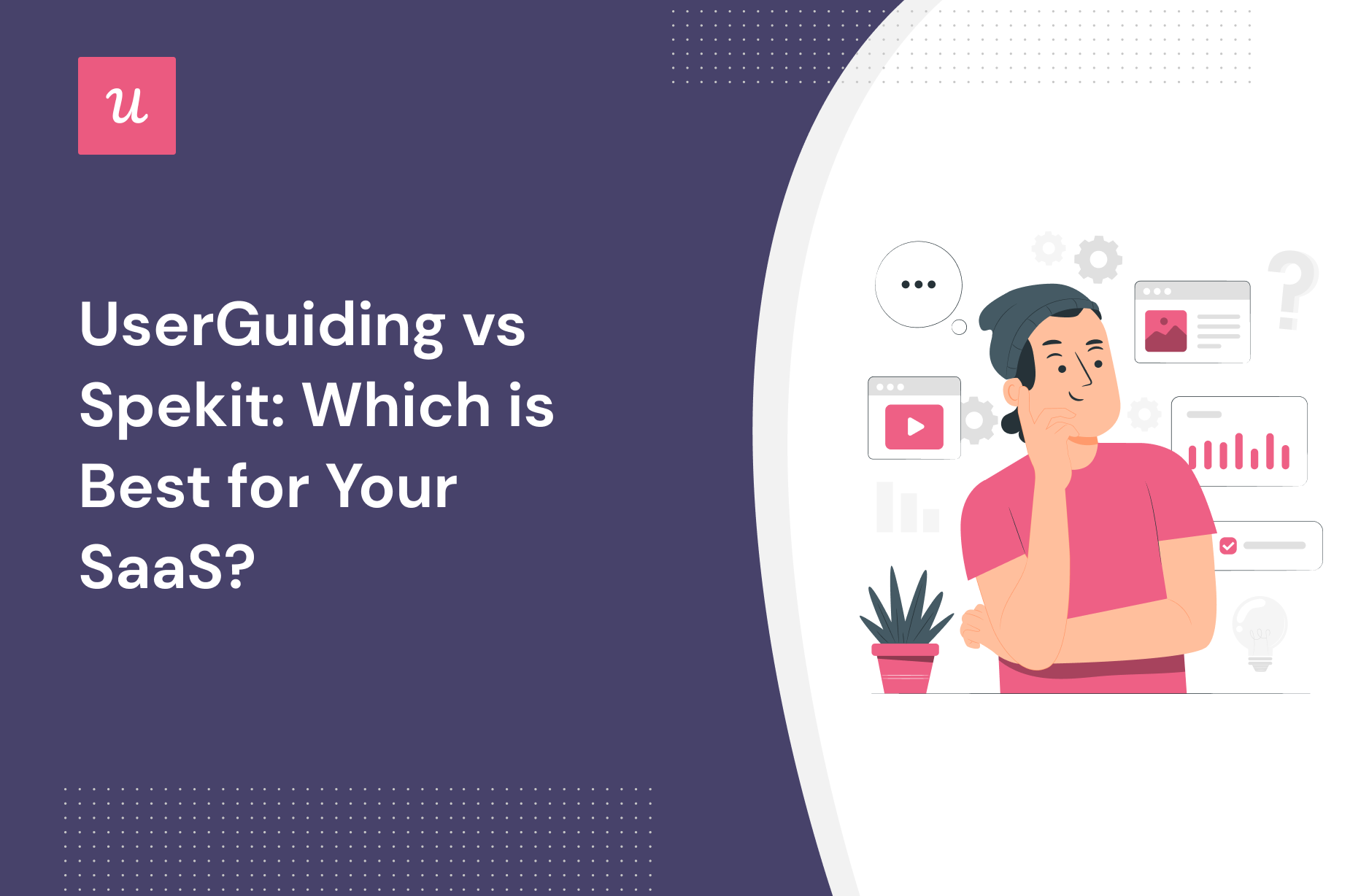
Thinking about whether to go for UserGuiding vs Spekit as your user onboarding software?
Which is the better tool for user onboarding, as well as other use cases? Which one offers the best value for money, and will be most appropriate for a company of your size, with your resources?
Let’s find out! In the post below, we’ve covered all the common use cases and done an in-depth analysis of the key features of UserGuiding and Spekit – as well as compared it to an alternative solution that may be better in some situations.
Try Userpilot Now
See Why 1,000+ Teams Choose Userpilot

TL;DR:
- UserGuiding and Spekit are user onboarding, user feedback, and user analytics tools and each has its pros and cons.
- Spekit helps you create step-by-step walkthroughs and guide customers, as well as educate employees on third-party apps.
- With Userpilot, you can build a huge variety of user onboarding experiences and in-app guidance flows without writing any code.
- With UserGuiding, you can examine account use and content performance in one place. With the help of this technique, you may improve your approach and acquire a better understanding of the success and engagement of your in-app experiences.
- With Spekit user analytics, you can record internal user activity and see how much time users spend in the app.
- Userpilot allows you to collect customer feedback, track in-app behavior and user interactions with your in-app experiences, as well as act on these insights.
- The Basic plan for UserGuiding provides you with NPS surveys and micro surveys. The drawback is that you can’t tag NPS replies to see trends between scores. Additionally, you are unable to develop lengthy forms due to the lack of support for such forms.
- With Spekit’s Knowledge checks, you can build short surveys to quiz your customers and employees.
- With Userpilot you can create custom user segments based on survey responses or NPS scores and trigger specific in-app flows for them.
Try the best employee onboarding tool for your SaaS now!

UserGuiding vs Spekit – similarities and differences
UserGuiding and Spekit are both applications for employee onboarding, user analytics, and user feedback with several areas of overlap. Both UserGuiding and Spekit are popular SaaS tools used mostly for employee onboarding in SaaS companies. Both products have several similar features.
However, there are several details about the way these particular features are “executed” in both products that may make a substantial difference for the buyer.
They also have very different pricing plans. Let’s look at the details.
UserGuiding vs Spekit for user onboarding – similarities and differences
In this section of the article, we’re really going to dig into the nitty-gritty of each area of product functionality. That way, we’ll be able to figure out which tool – UserGuiding or Spekit – is the best option depending on your use case.
UserGuiding for user onboarding
As a no-code onboarding tool, UserGuiding has numerous features that will help you create onboarding flows for your new customers and guide them throughout their journey.
Here’s what you’ll get when you start using UserGuiding:
- Create interactive product walkthroughs without disturbing your developers as it’s completely code-free.
- Build onboarding checklists and drive customers to the activation point by eliminating the guesswork on what the next step should be.
- Use a variety of UI patterns, like checklists tooltips, modals, and slideouts to prompt the right in-app experience, to the right persona, at the right time in their user journey.
- Add emojis, gifs, images, or videos to customize your onboarding flows and have them match your brand.
Though UserGuiding is a great tool for startups that don’t have much money to invest in an onboarding tool, it has very strict limitations for the Basic plan.
You can only create a maximum of 20 guides, 2 onboarding checklists, and 1 resource center. If you want to create unlimited guides with unlimited UI patterns, you should go for the Professional plan that costs $299.
Spekit for user onboarding
Spekit is not a truly user onboarding tool. It’s built to streamline employee onboarding by guiding new employees through 3rd party tools and processes using no-code, step-by-step walkthroughs.
Here’s how Spekit helps with employee onboarding:
- Spekit’s step-by-step walkthroughs help you build flows for guidance. You can create individual onboarding journeys for different teams. However, the variety of UI patterns is limited to tooltips and modals.
- Spekit allows you to record your flows and edit them, or save them as a draft. You can confirm the positioning of steps looks good, make necessary edits to the texts, and delete steps that are not necessary.
- With spotlights, you can push changes, new resources, or updates to your team the moment they need it – directly within their workflows.
- You can use a single flow to guide employees across multiple tools.
All in all, Spekit has good functionality for employee onboarding but is lacking in collecting user sentiment throughout the onboarding process, as it doesn’t support surveys.
Better alternative for user onboarding – Userpilot
Userpilot was built specifically for SaaS product teams that want to improve their user onboarding experience and boost user activation.
You can build a huge variety of user onboarding experiences and in-app guidance flows without needing to code.
Get the best value for money and drive growth at every stage of the user journey.
Here’s what you’ll get when you start using Userpilot:
- Forget about coding in-app experiences: Userpilot is a no-code solution and only requires your dev to install a line of javascript inside your app and for you to download a chrome extension that opens up the visual builder.
- Build in-app flows using the largest range of UI patterns (modals, slideouts, tooltips, hotspots, banners) and in-app onboarding experiences (checklists, microsurveys, NPS surveys, in-app resource center).
- Get access to a built-in NPS tool for collecting and analyzing user sentiment so you can improve your onboarding process based on real data.
- Create and track combinations of in-app events like clicks, hovers and form fills, and then analyze all these interactions under your own custom events, which can be built without code or API calls.
- Use advanced product analytics and in-app flows analytics to identify where users need help and create granular user segments to trigger in-app experiences contextually (segment based on user identification data, in-app engagement, custom events, clicks, hovers, form fills, user feedback responses, NPS scores and more).
- Enhance the onboarding experience with in-app help by launching a Resource Center directly inside your app. Add in-app guides, and video tutorials, and give users access to search the knowledge base or reach out to support. Self-service has never been easier.
The best user onboarding is contextual and it happens right where the users need it, inside your app. There isn’t a better user onboarding tool out there that offers more value for the money than Userpilot.
Schedule a demo with our team and get ready to build the best onboarding experiences your users have seen.
Try Userpilot – the best user onboarding solution for SaaS
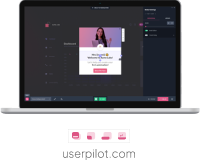
UserGuiding vs Spekit for user analytics – similarities and differences
Let’s explore each area of product functionality for user analytics and figure out which tool – UserGuiding or Spekit – is the best option depending on your use case.
UserGuiding for user analytics
UserGuiding Content Analytics Dashboard gives you a consolidated view of account usage and content performance.
Using this method, you can gain a better understanding of the engagement and success of your in-app experiences and refine your strategy.
This is how UserGuiding’s analytics dashboard can benefit you:
- Analyze the performance of your onboarding material in detail. This will allow you to figure out what’s working and what’s not.
- Track how users interact with your app in a given time period and identify product trends.
- Monitor real-time user engagement.
Spekit for user analytics
Spekit is a product adoption tool with the main focus on employee onboarding. When it comes to user analytics, it provides limited information regarding users and flows.
For instance, you can see the status of your flows (completed, incomplete, not started) but you can’t detect friction points in case of incomplete tasks, therefore you can’t improve user experience.
Let’s learn what insights Spekit’s user analytics provide:
- Spekit analytics only record internal user activity. So you won’t be able to see how your external users perform in your application.
- You can see how much time your users spend on flows and spotlights but that is pretty much it.
- You can collect user sentiment with emoji reactions but you won’t be able to collect qualitative data.
As you can see, Spekit provides simple analytics. But in order to gain more insights into analytics, you will need to use a separate user analytics tool with it that will track user behavior and provide proper analytics.
Better alternative for user analytics: Userpilot
You can’t drive success, no matter what your goals are, without proper user analytics. When it comes to proper user onboarding that drives long-term product adoption, Userpilot has the right analytics to help you succeed.
Let me explain.
I’m not talking about product usage only. Analytics is about collecting customer feedback, and tracking in-app behavior but also tracking how users engage with your in-app experiences. Right?
You need all of these for a proper picture of how healthy your product is. And then you need to be able to act on those insights.
That’s where proper user segmentation capabilities come in. And Userpilot has you covered here.
Userpilot has really improved in terms of its analytics functionality in recent years, and now offers the most robust functionality from all the product adoption platforms (including Pendo, which has always taken prime in user analytics.)
In short, Userpilot analytics allows you to:
- Track all of your user interactions with your app – without coding- with the powerful feature tagging functionality, you can simply tag your users’ actions (clicks, hovers, form fills) with a no-code, point-and-tag editor on top of your product.
- See all your user clicks, activity trends, etc. in an easy-to-use dashboard – Userpilot also allows you to drill down into feature usage, down to the individual user level, as well as company level.
- Analyze your user paths from up to 4 pages at a time, at a glance.
- Create ‘user funnels’ made up of feature tags and tracked events, and see where your users are dropping out of the funnel – and act on these drop-off points instantly with in-app experiences.
- Create and track combinations of in-app events like clicks, hovers and form fills, and then analyze all these interactions under your own custom events, which you can build without code or API calls.
- Create custom events that consist of feature tags as well – or combinations of tracked events you’ve passed through the Userpilot track script with features you have tagged with the Chrome Extension.
- The powerful trends overview allows you to filter your events and feature tags’ usage by segments, time period, and even company. This allows you to track and analyze event usage trends and even drill down to the individual users (or companies) who engaged with specific custom events and show them the right in-app experience.
- Apart from product usage data, Userpilot also has built-in analytics for in-app engagement with in-app flows and experiences.
- Analyze how users engage with your checklists or resource center modules, identify trends, and A/B test different approaches to improve engagement.
- Last but not least, Userpilot allows you to use all that data to build highly granular user segments and reach users with the right engagement flows at the right time.
- You can even create user segments based on survey responses or NPS scores.
Now, with so much power on your hands – what are you going to do with all this data?
Try Userpilot – the best user analytics solution for SaaS

UserGuiding vs Spekit for user feedback – similarities and differences
Finally, most SaaS companies considering UserGuiding vs Spekit want to look at their functionality for user feedback. Let’s dive into it in more detail.
UserGuiding for user feedback
With UserGuiding, you can collect user sentiment data with NPS surveys and microsurveys even when using the Basic plan.
Here’s how you can collect user feedback with UserGuiding:
- Build NPS surveys without writing a single line of code.
- Adjust the thank you page and add a follow-up question to gather qualitative data and understand the reasons behind the scores.
- Customize the button texts, colors, and designs to match your brand.
- Set up custom audiences, segments, timing, and targeting rules to trigger the surveys.
The downside of using UserGuiding for collecting user feedback is that you can’t tag NPS responses so you can identify trends between scores. You also can’t create long forms as they neither support it in their native interface nor have integrations with other 3-rd party tools to do the job.
Considering that, Userpilot undoubtedly offers you more value for money. You can build micro surveys, embed Typeform long surveys, collect and analyze NPS responses, and segment users based on scores and responses so you can trigger more personalized experiences.
Get a Userpilot demo here!
Spekit for user feedback
Here’s what you can do using Spekit’s Knowledge checks:
- Build short surveys designed to quiz your employee’s knowledge about the platform they are using.
- Trigger those surveys in-app to specific user segments.
- Determine who passes based on your selected answers and required completion.
Not exactly user feedback, but the surveys you can build with Spekit are interactive and accessible in-app, which increases engagement with them. If you want to collect true user feedback in various stages of the journey you should look at a different tool.
Better alternative for user feedback – Userpilot
There are two types of feedback you should be focusing on collecting to better understand the health of your product and users.
First, you have user sentiment which looks at user satisfaction and effort scores or loyalty (using NPS surveys). Then you may also want to collect feedback on the functionality of the product or specific features.
You can do all these with Userpilot. In short, you can:
- Collect and track (NPS) in-app with a built-in NPS widget that allows you to fully customize the survey look and feel, and set the trigger frequency and specific targeting.
- Analyze NPS scores, tag responses, and use the data to create specific user segments.
- Build and trigger in-app micro surveys like the classic PMF survey, or similar ones and mix multi-choice and open-ended types of questions to collect specific insights.
- Be in charge of who gets which survey type and when with advanced segmentation capabilities, and of course, you can use the answers to segment your audience.
The advantage of using Userpilot for collecting feedback over other survey tools is that you can better control who sees the surveys but also you can instantly use the data collected to segment your user base and trigger the right experience for them.
For instance, if your users give you a low NPS score because they think you’re missing a critical feature (that you actually have already), you can push an interactive walkthrough guiding them to find and explore this feature.
Conclusion – which tool is better for your SaaS, UserGuiding or Spekit?
Hopefully, this post helped you decide whether Spekit or UserGuiding is more appropriate for your company. As you can see – both have many upsides and downsides.
Undeniably, Userpilot provides a better value for money and is a better choice for a mid-market SaaS, especially when it comes to user onboarding and user feedback.
If you’re interested in finding more book a demo with our team here!
Try Userpilot – the best user onboarding solution for SaaS


